In the 1890s and early 1900s, rising population in the Chicago made the countryside more appealing. Chicago business leaders looked to rural areas within commuting distance of the city to build country homes for their families and indulge their passion for farm pursuits, including raising horses.
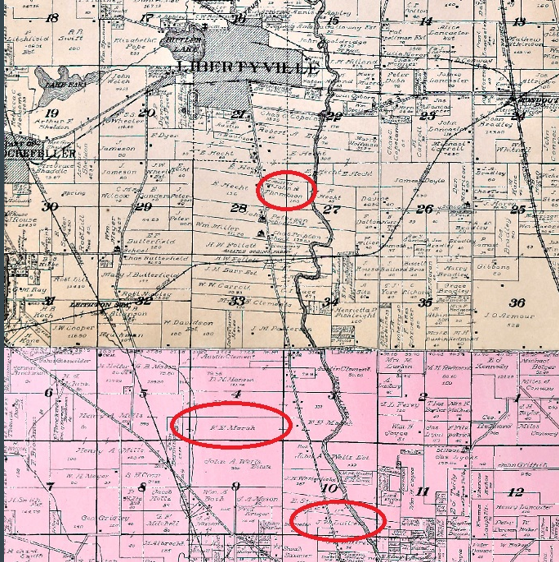
Chicago restauranteur John R. Thompson and railroad executive J.W. Lutrell were among these gentleman farmers who purchased farms in the area around the turn of the 20th century. They were attracted to the area by the already established success of horseman F.E. Marsh and his well known Gratton Stock Farm in Half Day/Prairie View. All three of their farms can be seen on the1907 plat map of Libertyville and Vernon Townships above.
Some of you may be familiar with Thompson’s farm under another name – Red Top Farm. Below is a later aerial view of the property. After Thompson, Red Top Farm was owned by Samuel Insull, Jr., Irving Florsheim, and Walter Mullady who all raised horses.
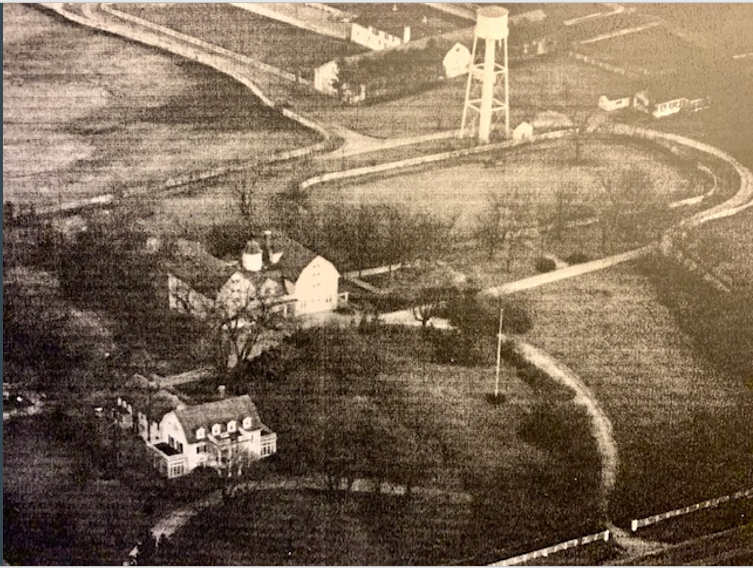
Thompson, Lutrell, Marsh and other local farm owners and businessmen with an interest in breeding trotters came together in late 1903 to form the Libertyville Trotting Association with the intention of building a race track. [1]
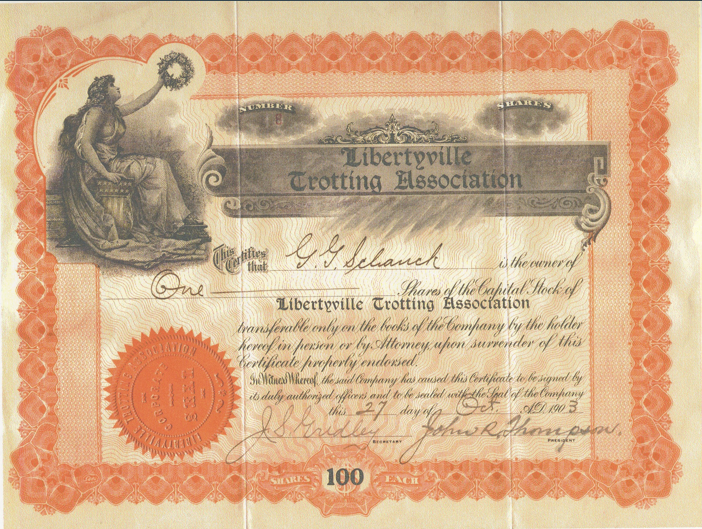
The timing aligns with the opening of the extension of the Chicago Milwaukee Electric Railroad from Lake Bluff to Libertyville. A.C. Frost, president of the railroad, provided the funds to purchase the land on the west side of Libertyville where the new racetrack was to be built. [2]
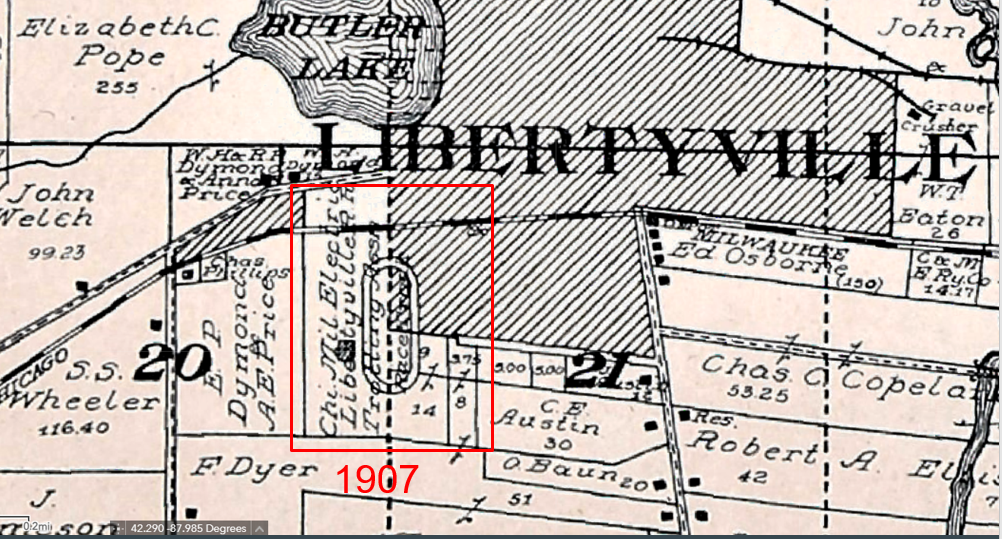
The Trotting Association facility would have been within walking distance of the main Libertyville depot on Milwaukee Avenue just south of today’s Route 176, but Frost also planned an extension to Mundelein, then known as Rockefeller, so race goers could be dropped off on the track’s doorstep. [3]
The extension can be seen on this later map.

As a side note, Ravinia Park was being constructed by the A.C. Frost Company along the electric line south of Highland Park at the same time as another way to increase ridership of the new electric line. [4]
The Lake County Independent published a reproduction of what they called the “blueprints” of the track, although it looks more like an artist’s rendering, in the May 20, 1904 issue.
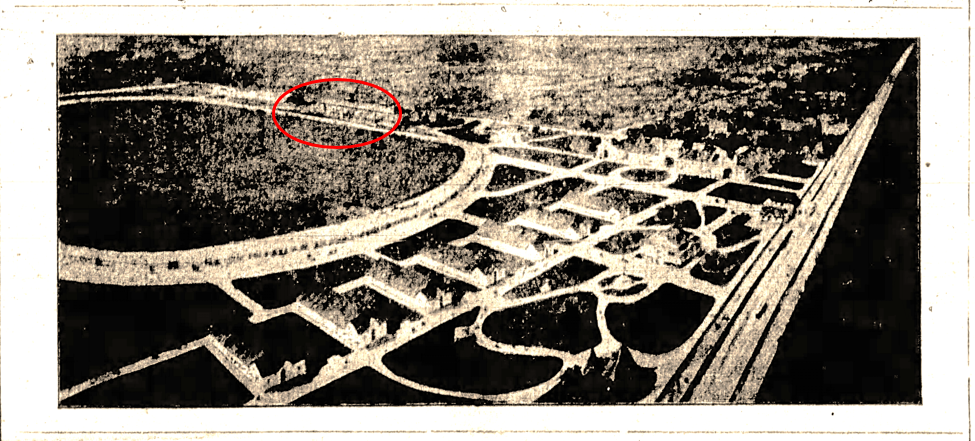
On the far right we can see the proposed electric railroad line which today is the North Shore Bike Path. The grandstand is circled in red.
Initial project costs were estimated at $300,000 (about $8.8 millionin today’s money) including the construction of the steel grandstand with a seating capacity of 5,000 people. [5]
The building of the new track was not without controversy.
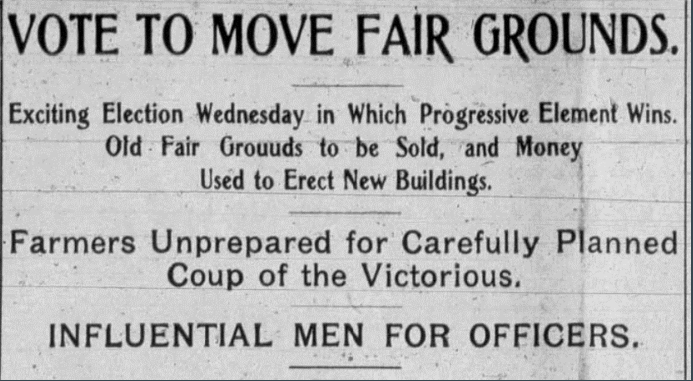
At the December 2, 1903 meeting of the Lake County Agricultural Society, the organization that ran the Lake County Fair, a slate of officers led by F.E. Marsh and other men with ties to the Trotting Association, “routed” the incumbents 225-23 in the Society’s board election. They ran on a platform of selling the fairgrounds on the north side of town and moving the fair to the Trotting Association facilities soon to be constructed. Cries of foul play – paying for votes and a preponderance of electric railroad employees coming in from the North Shore to vote in the election – arose. [6]
It’s no surprise that in a letter to the newspaper, electric railroad president A.C. Frost supported the new officers: “My first interest is in making a greater fair, something on a huge scale and that is going to attract patronage from a wide territory….Hold a fair, one that will eclipse anything heretofore attempted. The people will be quick to appreciate their [the new officers] endeavors and sincerity, and the time is not far distant from when you will thank them for what they have done.” [7]
The longtime fair organizers didn’t seem so inclined.
Apparently the Society’s by-laws specified a certain day on which elections were to be held. The Secretary of the Society discovered he had called the election for the wrong day. He quickly called a second election for the right day and early in the morning. The election was over before the track-associated people knew about it. The old board was therefore re-elected, refused to turn over the books and continued to hold meetings to plan the fair. The Trotting Association took them to court. [8]
Over the next several months, both sides moved forward with plans. The Lake County Agricultural Society put on a large fair on the existing fairgrounds and placed special effort on providing plentiful racing, perhaps to spite the Trotting Association. [9]
Although the Trotting Association announced plans to hold their own fair at the new grounds, they were not able to complete the needed exhibition buildings in time, nor the electric railroad extension. The extension was delayed by problems acquiring the right of way and wouldn’t open until Spring 1905. The Trotting Association had to settle for horse races only. [10] The competing interests appeared almost side by side on the front page of the September 2, 1904 newspaper.
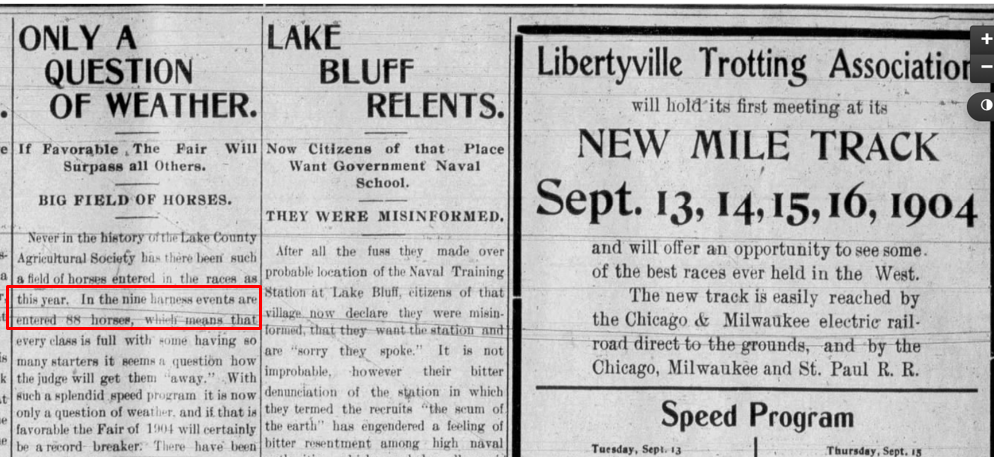
In October, after both events had occurred, the trotting interests dropped the case. There was no opposition when the Agricultural Society elections were held in December 1904. [11]
Anticipation for the September 1904 premiere of the new track was high. The week before opening day the newspaper reported that the horsemen who had already arrived at the track for practice workouts declared the track very fast and argued that “there is not another course with as perfect and desirable turns.” [12] One hundred thirty-five horses were entered in eleven trotting or pacing events. While the majority of the horses were from Illinois or adjoining states, horses from as far away as Oklahoma and Idaho made the trip to compete on the new track. [13] Unfortunately, Mother Nature didn’t cooperate. The opening day races on September 13, 1904 were cancelled and the entire schedule pushed back one day. [14]
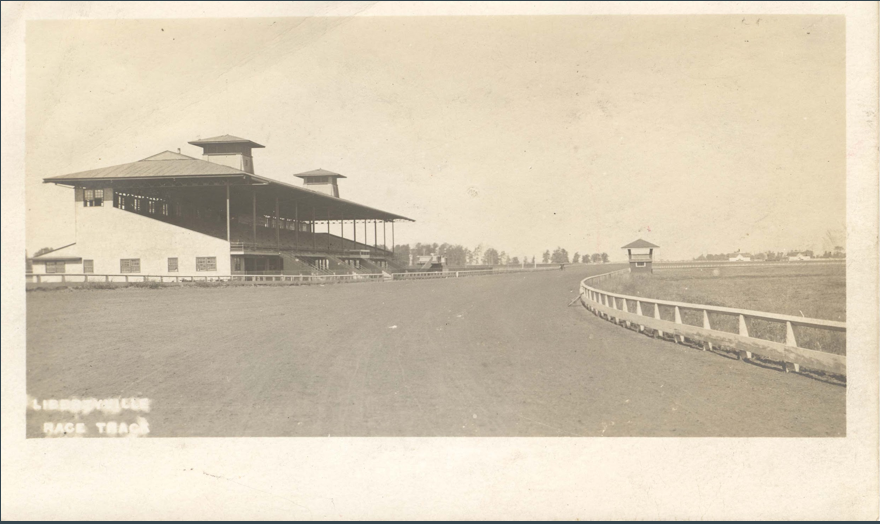
With better weather over the weekend, race goers were able to enjoy comfortable seats with good sightlines, meals at either the lunch counter or dining room, and drinks at the bar under the amphitheater. Wagers in the form of auction pools could be placed in the betting ring on the ground floor. The week after the races, the newspaper reported that while attendance was not high, the event did not lose money, and the management was satisfied with this inaugural event. [15]
The 1905 season looked promising. By the end of April 1905, seventy horses were in residence at the track for training season with more expected in the next week. The Libertyville Trotting Association announced that they would host two meets that year – one in July and another in September. Unfortunately, the July meet did not garner enough entrants to hold four days of racing and the event was reduced to just one day. [16]
Rain again kept attendance low at the July 4th meeting. The Lake County Independent reported that bookmakers were “doing a quiet and rather slow business.” The bar at the racetrack was operated jointly by seven Libertyville saloon operators who complained they didn’t make much money. The newspaper assured the reading public that “It was a quiet, orderly crowd and not an incident occurred to mar the day’s pleasure.” [17] This was an important point as the opponents of liquor and gambling throughout the state were stirring up trouble for the horse racing industry.
Horseracing and gambling went hand in hand. Social reformers thought gambling was a corrupting influence. Efforts to stop it are seen in the Chicago area as early as the late 1800s and came to a head in the first decade of the 20th century resulting in Illinois enacting a blanket ban on gambling in 1905. [18] (For an in-depth look at this issue, see Horse Racing the Chicago Way: Gambling, Politics , and Organized Crime, 1837-1911 by Steven Riess.)
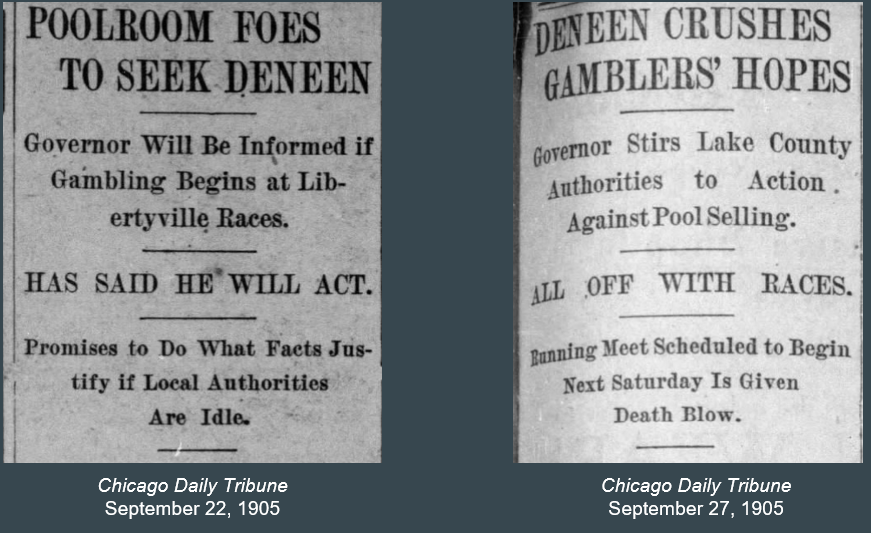
One 1905 event at the Libertyville track was in the cross hairs. The Harlem Jockey Club planned to hold a month long running race meeting at the Libertyville track. The club’s president, John Conden, also known as “Blind” John Condon, was a well-known, politically-connected leader of a Chicago gambling syndicate. The Harlem Racetrack in Harlem, IL (now Forest Park) had held its last race in 1904 after a crackdown on gambling at race tracks in Chicago and Cook County. Perhaps they thought they could get away with it in Lake County since up to this point the State’s Attorney had been reluctant to prosecute gamblers. [19]
Libertyville Methodist pastor Rev. T. R. Quayle went all the way to the governor with his concerns about the event. Governor Deneen threatened that if officers failed to discharge their duty in the flagrant violation of gambling, he would act on it. Although Condon claimed that the majority of Libertyville’s “best citizens and merchants” supported the event and that the intention was to have a “clean-cut meeting,” he ultimately cancelled the event. [20]
The Libertyville Trotting Association was also under the eye of Rev. Quayle and took measures to stay on the up and up. For the 1906 meeting, the Trotting Association brought in two dozen “big Pinkerton policeman” to keep an eye on things. [21]
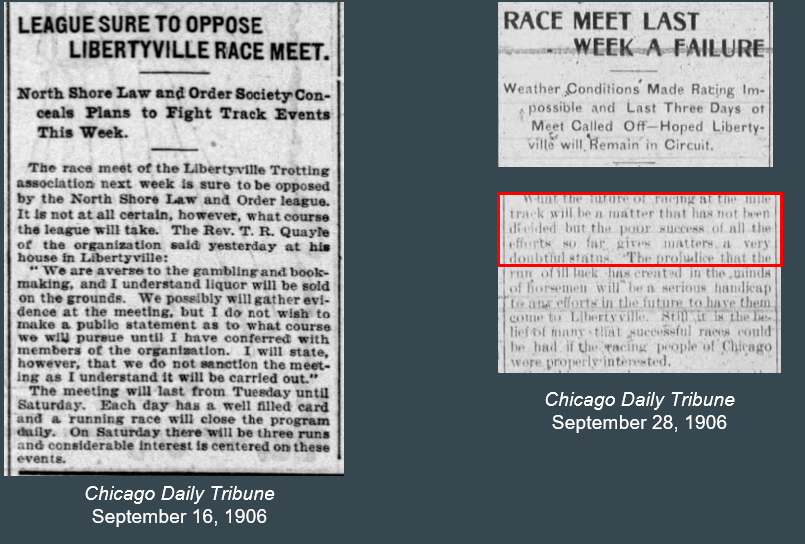
The 1906 meet was held but again weather kept crowds away and the final days of the meet were called off. The meet was deemed a failure. The future of the track was called in to question after only two years of operation. Word must have spread quickly. The next week’s newspaper reported that the Wisconsin State Fair was interested in purchasing the grandstand. [22]
The last identifiable race meeting at the track was held in the 1907 season. The Libertyville Track was included on the list of 1908 Great Western Trotting Circuit races, but there were no newspaper articles about the race near the scheduled date. [23]
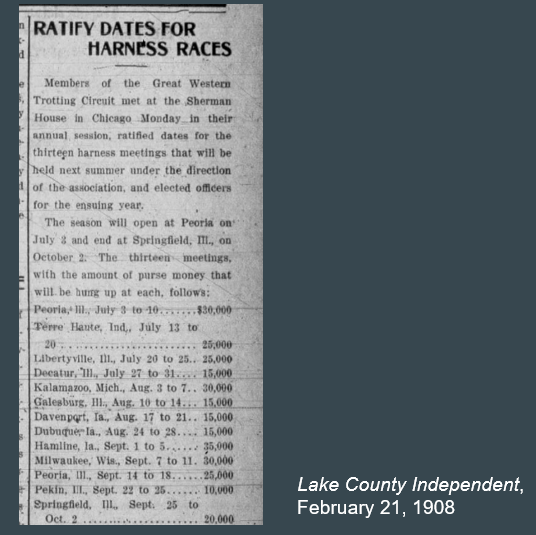
The race track’s prospects weren’t helped by 1909 foreclosure proceedings and freak weather. F.E. Marsh purchased the track from the bank, but within a year he decided to sell it to an attorney from Milwaukee. In April 1909, a storm knocked down 40 stalls, a number of sheds, the ticket offices, and blew away the two cupolas on top of the grandstand. [24]
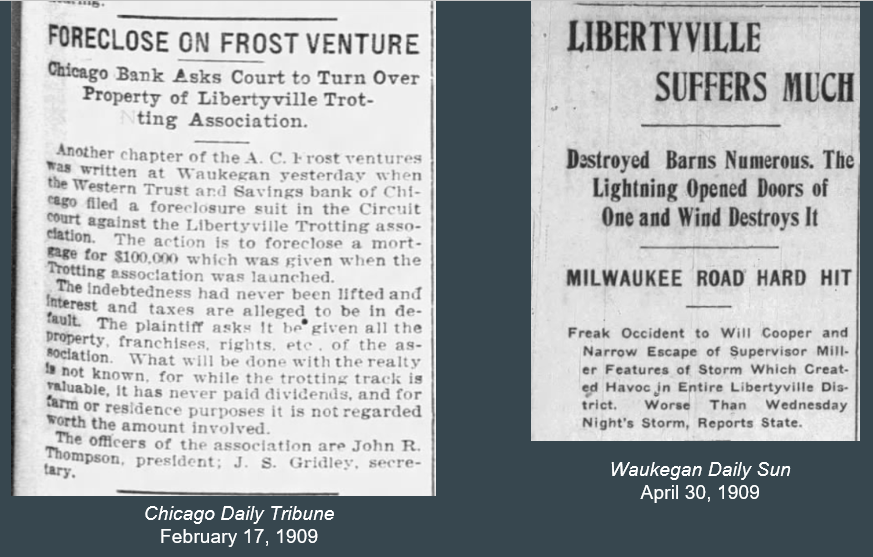
Other events, such as motorcycle racing, made use of the track. A series of races held the fall of 1909 were well attended. Additional races were held in 1910 and were successful enough that the Chicago Motorcycle Club wanted to lease the track. It’s not clear if a lease was ever signed. [25]

At one time there was speculation that the Ringling Brothers circus was planning on leaving Baraboo, WI and purchasing the track to use as their winter home. Turned out it was just a rumor, but it is fun to imagine a line of elephants walking the track in place of the horses. Ultimately, the circus didn’t come to town. Instead, well-known horse trainer Dick McMahon leased the track and reestablished its reputation as a training center. [26]
Maybe the biggest race ever held at the One Mile track was not a horse race, but an automobile race. Part 3 of Libertyville’s Racetracks will discuss this major car race and the track’s final years.
Part 3: Libertyville’s Racetracks
Part 1: Libertyville’s Racetracks
Sources used in this post can be found in the Cook Memorial Public Library District collection.
Sources
- “New Trotting Club is Formed.” Chicago Daily Tribune, December 5, 1903, p.8.
- “Formal opening of the electric.” Lake County Independent, September 4, 1903, p. 1; “Libertyville Track, Costing $150,000, sold for $25,000.” The Inter Ocean, November 14, 1913, p.13, Newpapers.com.
- “Work on extension begins; electric road service by January 1.” Lake County Independent, October 21, 1904, p. 1.
- “History of Ravinia.” https://www.ravinia.org/History. Accessed May 10, 2023.
- “Busy at New Track.” Lake County Independent, May 20, 1904, p.1.
- “Vote to Move Fairgrounds.” Lake County Independent, December 4, 1903, p.1.
- “Fair Suit Filed Thursday.” Lake County Independent, February 19, 1904, p.1.
- “Fair Suit Dropped.” Lake County Independent, October 7, 1904, p. 1.
- “Only a Question Weather.” Lake County Independent, September 2, 1904, p.1.
- “Vote to Move Fairgrounds.” Lake County Independent, December 4, 1903, p.1; “Announcement.” Lake County Independent, March 24, 1905, p.1; “Eight suits started; electric railroad begins action to condemn valuable property.” Lake County Independent, June 10, 1904, p. 1; “Seek to stop the electric road.” Lake County Independent, November 25, 1904, p. 1; “Busy getting the right-of –way (for electric road).” Lake County Independent, April 29, 1904, p. 5.
- “Fair Suit Dropped.” Lake County Independent, October 7, 1904, p. 1; “Fair Officers Elected.” Lake County Independent, December 9, 1904, p.1.
- “Ready for Big Races.” Lake County Independent, September 9, 1904, p.1.
- “Entry List.” Lake County Independent, September 9, 1904, p.4.
- “Libertyville Card Postponed.” Chicago Tribune, September 14, 1904, p.8.
- “All But Weather Satisfactory.” Lake County Independent, September 16, 1904, p.1.; “Four Days of Great Racing.” Lake County Independent, September 23, 1904, p.1.
- “Many Fast Horses on Track.” Waukegan Daily Sun, April 21, 1906, p.1.; “May Hold Two Meetings: Harness Horse Sport for the Track at Libertyville.” Chicago Daily Tribune, May 21, 1905. p. A3; “Abandon 4 Day Meeting.” Lake County Independent, June 30, 1905, p.1.
- “Rain Keeps Crowds Away.” Lake County Independent, July 7, 1905, p.1.
- “Horse Racing.” In Encyclopedia of Chicago, http://www.encyclopedia.chicagohistory.org/pages/601.html. Accessed May 10, 2023; Johnson, J. Keeler. “Two Tracks, One Legacy: The Story of Washington Park.” American Racehorse, March 27, 2020. https://issuu.com/southernracehorse/docs/washington_park_-_american_racehorse. Accessed May 12, 2023.
- “Poolroom Foes to Seek Deneen.” Chicago Daily Tribune, September 22, 1905, p.7. Newspapers.com.
- “Deneen Crushes Gamblers’ Hopes.” Chicago Daily Tribune, September 27, 1905, p.3.; “Running Race Meet is All Off.” Lake County Independent, September 29, 1905, p.1.
- “League Sure to Oppose Libertyville Race Meet.” Chicago Tribune, September 16, 1906, p.7. Newspapers.com; “Local Items to Libertyville Readers Picked Up Here and There.” Lake County Independent, July 6, 1906, p.5.
- “Race Meet Last Week a Failure.” Lake County Independent, September 28, 1906, p.1; “Want Libertyville Track.” Lake County Independent, October 5, 1906, p.1.
- “Ratify Dates for Harness Races.” Lake County Independent, February 21, 1908, p.1.
- “Foreclose on Frost Venture: Chicago Bank Asks Court to Turn Over Property of Libertyville Trotting Association.” Chicago Tribune, February 17, 1900, p.11; “Clark’s Review of Harness Horses.” Inter Ocean, January 16, 1910, p.26. Newspapers.com.; “Mile Track is Sold.: Atty Hansen of Milwaukee Acquires Property.” Lake County Independent, March 31, 1911, p.8; “Libertyville Suffers Much.” Waukegan News Sun, April 20, 1909, p.7. Newspapers.com.
- “Motorcycle races at Libertyville.” Lake County Independent and Waukegan Weekly Sun, October 1, 1909, p. 1; “Roy Yeoman won motorcycle race.” Lake County Independent and Waukegan Weekly Sun, September 24, 1909, p. 1; “Notes.” The Chicago Live Stock World, July 12, 1910, p. 2; “Chicago Motorcycle Club with Champion Fred Huyck as Member Seeks Lease for Year on Libertyville Mile Track.” Waukegan News Sun, July 8, 1910, p.1
- “May Sell Mile Track.” Lake County Independent, July 12, 1912, p.1; “Believe Report About Ringlings Without Basis.” Lake County Independent, August 2, 1912, p.9; “Report Trotting Track is Sold.” Lake County Independent, August 2, 1912, p.1; “Ringlings Not to Winter at Libertyville.” Lake County Independent, September 6, 1912, p.1; “Lake County Now Stands No Chance of Getting Circus.” Lake County Independent, November 22, 1912, p.16; “McMahon Leases Track.” Lake County Independent, March 22, 1912.; “Never Once Has a String of Horses Like at Present Been Seen at Libertyville Track.” Lake County Independent, May 16, 1913. p.9.
Categories: Local History
Tags: Local History
